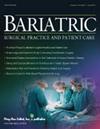在腹腔镜减肥手术中,气腹前应用反向Trendelenburg体位对视神经鞘直径的影响:一项随机对照研究
IF 0.3
4区 医学
Q4 NURSING
引用次数: 0
摘要
背景:腹腔镜手术通常与颅内压(ICP)升高有关。在减肥手术中,体位变化对视神经鞘直径(ONSD)测量ICP的影响还有待研究。我们的目的是评估在腹腔镜袖式胃切除术中位置变化对ONSD值的影响。方法:选取104例行腹腔镜袖式胃切除术的肥胖患者。根据仰卧位(SP组,n = 51)和逆Trendelenburg位(RTP组,n = 53)启动气腹,将患者分为两组。术中测量不同时间点的ONSD: T0(基线,麻醉诱导前)、T1(气管插管后)、T2 (SP组气腹后、RTP组体位后)、T3 (SP组体位后、RTP组气腹后)、T4(术中)、T5(消肿后)。不同时间点的ONSD测量和术后恶心呕吐是主要结果。结果:RTP组T2时ONSD值显著低于SP组(p < 0.001)。在T4和T5时间点,RTP组的ONSD值显著降低(p = 0.004和p = 0.040)。结论:在腹腔镜减肥手术中,以反Trendelenburg体位开始气腹可显著降低ONSD值。本文章由计算机程序翻译,如有差异,请以英文原文为准。
Effect of Reverse Trendelenburg Position Applied Before Pneumoperitoneum on Optic Nerve Sheath Diameter in Laparoscopic Bariatric Surgery: A Randomized, Controlled Study
Background: Laparoscopic surgery is usually associated with increased levels of intracranial pressure (ICP). The impact of positional changes on ICP measurements via optic nerve sheath diameter (ONSD) in bariatric surgery has yet to be studied. We aimed at evaluating the impact of positional changes on ONSD values during the laparoscopic sleeve gastrectomy. Methods: One hundred and four obese patients who underwent laparoscopic sleeve gastrectomy were recruited. Patients were allocated into two groups based on initiating pneumoperitoneum in supine (Group SP, n = 51) and reverse Trendelenburg (Group RTP, n = 53) positions. Intraoperative ONSD measurements were performed at different time points: T0 (baseline, before anesthesia induction), T1 (after endotracheal intubation), T2 (after pneumoperitoneum in Group SP and after positioning in Group RTP), T3 (after positioning in Group SP and after pneumoperitoneum in Group RTP), T4 (intraoperative), and T5 (after desufflation). ONSD measurements at different time points and postoperative nausea-vomiting are the primary outcomes. Results: ONSD values at T2 in Group RTP were significantly lower than in Group SP (p < 0.001). For T4 and T5 time points, there were significantly lower ONSD values in Group RTP (p = 0.004 and p = 0.040). Conclusions: Initiation of pneumoperitoneum in reverse Trendelenburg position resulted in significantly lower values of ONSD during laparoscopic bariatric surgery.
求助全文
通过发布文献求助,成功后即可免费获取论文全文。
去求助
来源期刊
CiteScore
0.80
自引率
0.00%
发文量
36
期刊介绍:
Bariatric Surgical Practice and Patient Care is the essential peer-reviewed journal delivering clinical best practices and quality updates for achieving optimal bariatric surgical outcomes.
Bariatric Surgical Practice and Patient Care coverage includes:
Quality outcomes measurement and reporting
Process innovations and care delivery
Short- and long-term surgical complications
Pre-surgical diagnosis and consultation
Pre-op, peri-op, and post-op standards of practice
Patient access
Patient safety issues
Nutritional and dietary support
Bariatric surgical emergencies
Best practices and current standards for bariatric surgery
Culture and ethics
Body contouring and reconstructive surgery
Bariatric teamwork and communication.

 求助内容:
求助内容: 应助结果提醒方式:
应助结果提醒方式:


